Nov 20, 2025
Nov 20, 2025
Andrew C Revkin, the Science reporter of New York Times has quoted a poem 'The Road To Heaven Is Too Dark', doing rounds in the internet circles. The poem is quite poignant as a child trapped under the debris of his school building is supposed to have penned it down for his mother. The child is too scared of dark and knows that his end is near and tells his mom that the road to heaven is too dark. It is pathetic indeed.
The afternoon of 12th May will haunt for years to come the memories of the residents of Sichuan Province of China, which was struck by an earthquake which snatched the lives of more than 900 innocent school kids. Their only fault was that they were in their classrooms when the earthquake struck. As the reports of more deaths are pouring in every day, there are reports of poor quality of construction of these school buildings in a well known earthquake prone zone.
Quoting Yumei Wang, head of the Geohazards team of Oregon he reports that excluding schools of California and Japan, most of the earthquake prone areas of the world have school buildings like palaces made of pack of cards!
Many a parents have been ruined by the loss of their precious kids in the recent earthquakes that visited Uttarakashi (India-1991), Chamoli (India-199
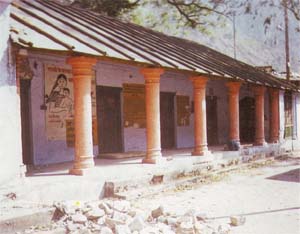 Are our school buildings safe? Let us take an example of Uttarakhand, a Himalayan state supposed to be one of the most vulnerable areas for earthquake disasters in the country. As per the vulnerability atlas areas most prone to earthquake are grouped in the zone V. Two districts of Uttarakhand, viz. Chamoli and Bageshwar are completely in this zone. In addition 98.3% of Rudraprayag, 18% of Almora and 17% of Uttarkashi districts are also in the same zone. Champawat, Udhamsingh Nagar, Nainital, Haridwar and Dehradun districts are in zone IV. In addition, 97% of Garhwal, 96.8% of Tehri Garhwal, 82% of Almora, and 83% area of Uttarkashi also falls in this zone only.
Are our school buildings safe? Let us take an example of Uttarakhand, a Himalayan state supposed to be one of the most vulnerable areas for earthquake disasters in the country. As per the vulnerability atlas areas most prone to earthquake are grouped in the zone V. Two districts of Uttarakhand, viz. Chamoli and Bageshwar are completely in this zone. In addition 98.3% of Rudraprayag, 18% of Almora and 17% of Uttarkashi districts are also in the same zone. Champawat, Udhamsingh Nagar, Nainital, Haridwar and Dehradun districts are in zone IV. In addition, 97% of Garhwal, 96.8% of Tehri Garhwal, 82% of Almora, and 83% area of Uttarkashi also falls in this zone only.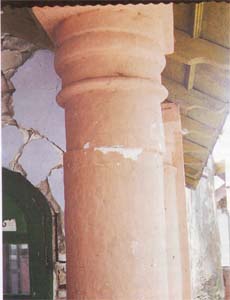 Uttarakhand always had a better literacy rate and accordingly the number of Primary, Higher Primary, Secondary and Higher Secondary schools in village areas alone is more than 20,000. The number crosses a staggering figure of plus 23,000 if the schools of urban areas are also added to the list. This number does not include scores of polytechnics, engineering colleges and degree colleges. The most earthquake prone districts of Bageshwar and Chamoli alone have more than 2350 schools. One does not need to be an expert in arithmetic to work out the approximate number of students that are present in these schools on any given day of the week! These kids spend on average around eight hours under the weak roofs and walls of their schools on working days.
Uttarakhand always had a better literacy rate and accordingly the number of Primary, Higher Primary, Secondary and Higher Secondary schools in village areas alone is more than 20,000. The number crosses a staggering figure of plus 23,000 if the schools of urban areas are also added to the list. This number does not include scores of polytechnics, engineering colleges and degree colleges. The most earthquake prone districts of Bageshwar and Chamoli alone have more than 2350 schools. One does not need to be an expert in arithmetic to work out the approximate number of students that are present in these schools on any given day of the week! These kids spend on average around eight hours under the weak roofs and walls of their schools on working days.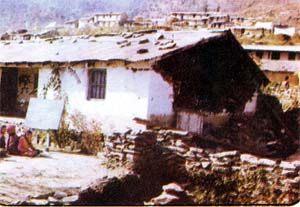 Geological Survey of India (GSI) has been regularly surveying Uttarakhand for working out the details of seismological studies. Majority of the school buildings in Uttarakhand are made of mud plaster with a few buildings made of cheap RCC structure. None of these buildings are safe enough to withstand the shock of an earthquake says Prabhas Pande, an eminent seismologist and Director Seismology of GSI.
Geological Survey of India (GSI) has been regularly surveying Uttarakhand for working out the details of seismological studies. Majority of the school buildings in Uttarakhand are made of mud plaster with a few buildings made of cheap RCC structure. None of these buildings are safe enough to withstand the shock of an earthquake says Prabhas Pande, an eminent seismologist and Director Seismology of GSI. 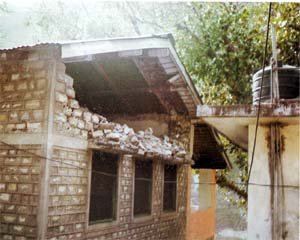 Well these are mere postulations, but a fact remains that the condition of school buildings and their approach roads is really bad all over Himalayas under countries jurisdiction. Nepal on the other hand has with the help of some NGOs managed to convert all school buildings earthquake resistant.
Well these are mere postulations, but a fact remains that the condition of school buildings and their approach roads is really bad all over Himalayas under countries jurisdiction. Nepal on the other hand has with the help of some NGOs managed to convert all school buildings earthquake resistant. 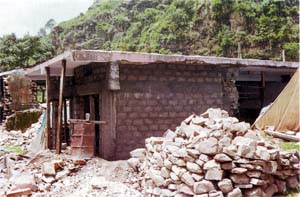 Retrofitting of school buildings costs 5% extra says Andrew C Revkin. Quoting Ben Wisner a retired Geography Professor is now a passionate organizer of experts devoted to cutting risks from inevitable disasters, says Revkin that when countries can spend $1 trillion annually on armies and weapons, why can't they spend a small amount in making school buildings earthquake safe! Retrofitting of school buildings, though a less costly option needs caution, because many a school buildings of the mountains may not be able to withstand hammering to drive in the steel rails etc.
Retrofitting of school buildings costs 5% extra says Andrew C Revkin. Quoting Ben Wisner a retired Geography Professor is now a passionate organizer of experts devoted to cutting risks from inevitable disasters, says Revkin that when countries can spend $1 trillion annually on armies and weapons, why can't they spend a small amount in making school buildings earthquake safe! Retrofitting of school buildings, though a less costly option needs caution, because many a school buildings of the mountains may not be able to withstand hammering to drive in the steel rails etc.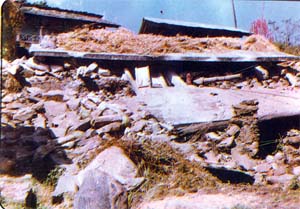 Preparedness of school kids and teachers is a must and for that specially designed programmes of dos and don'ts are easily available. National Disaster Management Authority (NDMA) of India, under the Ministry of Home Affairs, Government of India has drawn up many such training programmes and keep enlightening the vulnerable state governments about them. In addition the Union building keeps allocating required funds for the safety of school buildings and buildings where people congregate regularly. These funds are hardly utilized says on condition of anonymity a state Government official from Uttarakhand. In many of the schools of Bageshwar in Uttarakhand posts of teachers are lying vacant, while required numbers of students are already enrolled. Thus the teachers available are not even sufficient to teach the regular curriculum it is impossible to expect them to teach about ways to safe life during an earthquake. In California the level of preparedness is so high that even if a nursery student goes to toilet he erects a small flag on his desk. An indicator for the teacher, that such and such student if a search needs to be carried after the earthquake should be found in the toilet.
Preparedness of school kids and teachers is a must and for that specially designed programmes of dos and don'ts are easily available. National Disaster Management Authority (NDMA) of India, under the Ministry of Home Affairs, Government of India has drawn up many such training programmes and keep enlightening the vulnerable state governments about them. In addition the Union building keeps allocating required funds for the safety of school buildings and buildings where people congregate regularly. These funds are hardly utilized says on condition of anonymity a state Government official from Uttarakhand. In many of the schools of Bageshwar in Uttarakhand posts of teachers are lying vacant, while required numbers of students are already enrolled. Thus the teachers available are not even sufficient to teach the regular curriculum it is impossible to expect them to teach about ways to safe life during an earthquake. In California the level of preparedness is so high that even if a nursery student goes to toilet he erects a small flag on his desk. An indicator for the teacher, that such and such student if a search needs to be carried after the earthquake should be found in the toilet. 9), Turkey (1999), Gujarat (India-2001), Algeria (2003), Morocco (2004), Mujaffarabad (Pakistan-2005) and now Sichuan, China. I have often repeated in my articles that earthquakes never kill any one. They are one of the most innocent natural disasters. People get killed by building collapse or landslides due to ground shaking. In the mountain terrains landslides often block the stream flows, generating giant lakes. People die of flooding due to submergence of safe areas and latter by floods when such 'dams' burst. This is what is happening in Sichuan province as an aftermath of the earthquake and some areas are under grave threat of floods.
This time there has been greater hue and cry by the press world over about the collapse of school buildings in the Chinese province. And it is very much required too. The science of seismology, developed more through experience of past shocks and consequences, now clearly spells out that places of congregation like schools, hospitals, places of worship, shopping malls etc have to be made earthquake safe. The existing buildings can be made safer by retrofitting or by reconstructing with locally available cheaper and lighter material and the new ones have to be built as per the earthquake safe design suitable for the area.
 Are our school buildings safe? Let us take an example of Uttarakhand, a Himalayan state supposed to be one of the most vulnerable areas for earthquake disasters in the country. As per the vulnerability atlas areas most prone to earthquake are grouped in the zone V. Two districts of Uttarakhand, viz. Chamoli and Bageshwar are completely in this zone. In addition 98.3% of Rudraprayag, 18% of Almora and 17% of Uttarkashi districts are also in the same zone. Champawat, Udhamsingh Nagar, Nainital, Haridwar and Dehradun districts are in zone IV. In addition, 97% of Garhwal, 96.8% of Tehri Garhwal, 82% of Almora, and 83% area of Uttarkashi also falls in this zone only.
Are our school buildings safe? Let us take an example of Uttarakhand, a Himalayan state supposed to be one of the most vulnerable areas for earthquake disasters in the country. As per the vulnerability atlas areas most prone to earthquake are grouped in the zone V. Two districts of Uttarakhand, viz. Chamoli and Bageshwar are completely in this zone. In addition 98.3% of Rudraprayag, 18% of Almora and 17% of Uttarkashi districts are also in the same zone. Champawat, Udhamsingh Nagar, Nainital, Haridwar and Dehradun districts are in zone IV. In addition, 97% of Garhwal, 96.8% of Tehri Garhwal, 82% of Almora, and 83% area of Uttarkashi also falls in this zone only.
 Uttarakhand always had a better literacy rate and accordingly the number of Primary, Higher Primary, Secondary and Higher Secondary schools in village areas alone is more than 20,000. The number crosses a staggering figure of plus 23,000 if the schools of urban areas are also added to the list. This number does not include scores of polytechnics, engineering colleges and degree colleges. The most earthquake prone districts of Bageshwar and Chamoli alone have more than 2350 schools. One does not need to be an expert in arithmetic to work out the approximate number of students that are present in these schools on any given day of the week! These kids spend on average around eight hours under the weak roofs and walls of their schools on working days.
Uttarakhand always had a better literacy rate and accordingly the number of Primary, Higher Primary, Secondary and Higher Secondary schools in village areas alone is more than 20,000. The number crosses a staggering figure of plus 23,000 if the schools of urban areas are also added to the list. This number does not include scores of polytechnics, engineering colleges and degree colleges. The most earthquake prone districts of Bageshwar and Chamoli alone have more than 2350 schools. One does not need to be an expert in arithmetic to work out the approximate number of students that are present in these schools on any given day of the week! These kids spend on average around eight hours under the weak roofs and walls of their schools on working days.
 Geological Survey of India (GSI) has been regularly surveying Uttarakhand for working out the details of seismological studies. Majority of the school buildings in Uttarakhand are made of mud plaster with a few buildings made of cheap RCC structure. None of these buildings are safe enough to withstand the shock of an earthquake says Prabhas Pande, an eminent seismologist and Director Seismology of GSI.
Geological Survey of India (GSI) has been regularly surveying Uttarakhand for working out the details of seismological studies. Majority of the school buildings in Uttarakhand are made of mud plaster with a few buildings made of cheap RCC structure. None of these buildings are safe enough to withstand the shock of an earthquake says Prabhas Pande, an eminent seismologist and Director Seismology of GSI.
Himalayas are more prone to earthquakes because of the constant sub-duction of the Indian Plate under the Tibetan Plate. Indian Plate is moving under the Tibetan plate @ five centimeter per year. The collision of these two plates some 120 million years ago gave rise to the lofty Himalayas. Even today the movement of the plate is making Himalayas to rise further and also building up 'strains'. When a part of plate gives way due to strain earth begins to shake. After studying the strain pattern of the plates all over Himalayas, Roger Bilham an eminent American Seismologist postulates that now there is a greater possibility of the plate under Northeastern Himalaya giving way. Prof K.S. Valdiya an eminent earth Scientist postulates a greater possibility of the plate under Central Kumaon in Uttarakhand breaking up and lead to a massive earthquake.
 Well these are mere postulations, but a fact remains that the condition of school buildings and their approach roads is really bad all over Himalayas under countries jurisdiction. Nepal on the other hand has with the help of some NGOs managed to convert all school buildings earthquake resistant.
Well these are mere postulations, but a fact remains that the condition of school buildings and their approach roads is really bad all over Himalayas under countries jurisdiction. Nepal on the other hand has with the help of some NGOs managed to convert all school buildings earthquake resistant.
Organization For Economic Co-operation and Development (OPED) a 30 nation consortium with headquarters in France has a number of experts under its wings, including experts on school building safety and experts to keep the students and teachers always prepared for the worst. India is not yet a member of the consortium, but a release from the OPED hopes that soon the country will join them. The consortium has carried out detailed surveys of all hazards vulnerable school buildings of its member nations. They have designed earthquake safe buildings for maximum anticipated shaking in particular areas. In addition they have either retrofitted old buildings or reconstructed them with the help of locally available cheaper material.
 Retrofitting of school buildings costs 5% extra says Andrew C Revkin. Quoting Ben Wisner a retired Geography Professor is now a passionate organizer of experts devoted to cutting risks from inevitable disasters, says Revkin that when countries can spend $1 trillion annually on armies and weapons, why can't they spend a small amount in making school buildings earthquake safe! Retrofitting of school buildings, though a less costly option needs caution, because many a school buildings of the mountains may not be able to withstand hammering to drive in the steel rails etc.
Retrofitting of school buildings costs 5% extra says Andrew C Revkin. Quoting Ben Wisner a retired Geography Professor is now a passionate organizer of experts devoted to cutting risks from inevitable disasters, says Revkin that when countries can spend $1 trillion annually on armies and weapons, why can't they spend a small amount in making school buildings earthquake safe! Retrofitting of school buildings, though a less costly option needs caution, because many a school buildings of the mountains may not be able to withstand hammering to drive in the steel rails etc.
 Preparedness of school kids and teachers is a must and for that specially designed programmes of dos and don'ts are easily available. National Disaster Management Authority (NDMA) of India, under the Ministry of Home Affairs, Government of India has drawn up many such training programmes and keep enlightening the vulnerable state governments about them. In addition the Union building keeps allocating required funds for the safety of school buildings and buildings where people congregate regularly. These funds are hardly utilized says on condition of anonymity a state Government official from Uttarakhand. In many of the schools of Bageshwar in Uttarakhand posts of teachers are lying vacant, while required numbers of students are already enrolled. Thus the teachers available are not even sufficient to teach the regular curriculum it is impossible to expect them to teach about ways to safe life during an earthquake. In California the level of preparedness is so high that even if a nursery student goes to toilet he erects a small flag on his desk. An indicator for the teacher, that such and such student if a search needs to be carried after the earthquake should be found in the toilet.
Preparedness of school kids and teachers is a must and for that specially designed programmes of dos and don'ts are easily available. National Disaster Management Authority (NDMA) of India, under the Ministry of Home Affairs, Government of India has drawn up many such training programmes and keep enlightening the vulnerable state governments about them. In addition the Union building keeps allocating required funds for the safety of school buildings and buildings where people congregate regularly. These funds are hardly utilized says on condition of anonymity a state Government official from Uttarakhand. In many of the schools of Bageshwar in Uttarakhand posts of teachers are lying vacant, while required numbers of students are already enrolled. Thus the teachers available are not even sufficient to teach the regular curriculum it is impossible to expect them to teach about ways to safe life during an earthquake. In California the level of preparedness is so high that even if a nursery student goes to toilet he erects a small flag on his desk. An indicator for the teacher, that such and such student if a search needs to be carried after the earthquake should be found in the toilet.
Are our children in the Himalayan states safe from the earthquake hazard? Only time and governments can answer this question. Till such time a greater socio-political will and involvement is required to save our future from perishing in their alma-maters.
01-Jun-2008
More by : V. K. Joshi (Bijji)